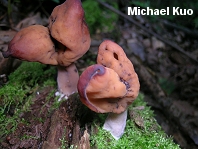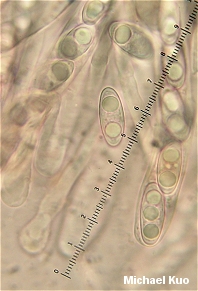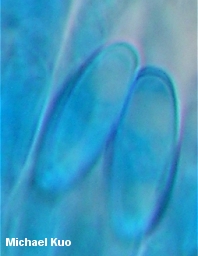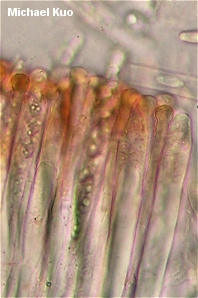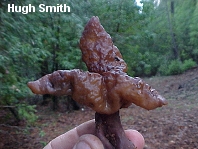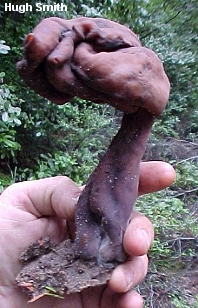| Major Groups > False Morels > Gyromitra infula |

|
Gyromitra infula [ Ascomycetes > Pezizales > Discinaceae > Gyromitra . . . ] by Michael Kuo This mushroom occurs in late summer and fall--not in the spring, when other species of Gyromitra can be found (in coastal California, however, it fruits in winter and spring). Its broadly lobed cap is usually pinched into two lobes, creating a saddle-shaped appearance. Its color is extremely variable. The West Coast version of Gyromitra infula (see the bottom illustrations), which may be a separate species, tends to get larger than its eastern counterpart, and seems more prone to 3-lobed and odd-ball manifestations. Additionally, this western mushroom is sometimes found growing terrestrially, while the eastern version is almost always found growing on wood. Gyromitra ambigua is a nearly identical species with spores measuring 22-30 x 7.5-12 µ and featuring a blunt apiculus at each end (1.5-3 µ), a smaller fruiting body with more violet colors, and northern distribution. The description of Gyromitra infula in Weber (1995) combines Gyromitra ambigua with Gyromitra infula. Thanks to the Herbarium of the University of Michigan for facilitating study of the collections cited below.Description: Ecology: Saprobic; growing alone, scattered, or gregariously on the well-decayed wood of conifers, or growing terrestrially near stumps and woody debris; widely distributed in North America but more common in northern and montane areas. Cap: 2-13 cm high; 2-8 cm across; occasionally nearly cup-shaped when young, but soon becoming lobed with two prominently raised lobes (rarely with 3 or 4 lobes); bald; loosely wrinkled but usually not not brainlike; color extremely variable (tan to yellowish brown to reddish brown to dark brown); undersurface whitish to brownish, finely dusted, sometimes ingrown with stem where contact occurs. Flesh: Thin and brittle; whitish to brownish; insubstantial or chambered. Stem: 2-12 cm long; up to 3 cm thick; not ribbed; colored like the cap or paler; finely dusted; developing folds near the base. Microscopic Features: Spores 17-24 x 7-11 µ; narrowly ellipsoid; with two large oil droplets (sometimes with 1 or 3 droplets); smooth; without apiculi, or with slightly thickened (under 1 µ) walls at the ends, creating the illusion of broad, very shallow apiculi (best seen with heated cotton blue). Asci 8-spored. Paraphyses capitate; 7-10 µ wide; with red granular contents. REFERENCES: (Schaeffer, 1770) Quélet, 1886. (Fries, 1822; Saccardo, 1889; Harmaja, 1969; Smith, 1975; Smith, Smith & Weber, 1981; Arora, 1986; States, 1990; Phillips, 1991/2005; Lincoff, 1992; Weber 1995; Abbott & Currah, 1997; Evenson, 1997; Barron, 1999; Kuo, 2005; McNeil, 2006; Miller & Miller, 2006; Trudell & Ammirati, 2009.) Herb. DBG RMNP 2008-11, RMNP 2008-12. Herb. MICH NSW-451, AHS-89710. Herb. Kuo 09039401, 09139701, 09110413, 02230502, 02230503, 02230504, 08120707. This website contains no information about the edibility or toxicity of mushrooms. |
© MushroomExpert.Com |
|
Cite this page as: Kuo, M. (2012, June). Gyromitra infula. Retrieved from the MushroomExpert.Com Web site: http://www.mushroomexpert.com/gyromitra_infula.html |
